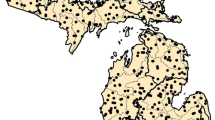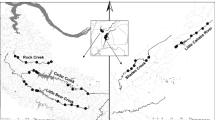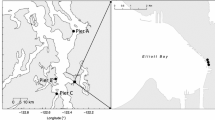Abstract
Historic land use changes and subsequent river channelization created deeply incised, unstable stream channels largely devoid of natural cover throughout the Yazoo River basin, Mississippi, USA. Large trash (e.g., televisions, toilets, car parts) dumped in streams provided shelter for some aquatic fauna. To determine whether trash served as a surrogate for natural cover, I examined crayfish use of both cover types. I sampled crayfishes by kick-seining 2 × 1-m plots in three cover classes: trash, natural cover, and no cover. I captured 415 crayfishes from 136 of the 294 plots. Most crayfishes were in natural cover (253), followed by trash (154), and no-cover (8) plots. Trash use varied by crayfish genus and size. Frequencies of all size classes of Procambarus and of the smallest Cambarus were higher in natural cover than trash. Many of the smallest individuals were found in live root mats. As Cambarus and Orconectes grew, they shifted more toward trash, and the largest Orconectes size class was significantly more abundant than expected in trash. Trash served as “artificial reefs,” providing cover for crayfishes and other fauna, but functioned differently than the remaining natural cover. The results confirmed that stream substrate did not provide adequate instream cover for crayfishes in the study area and suggested that high-quality natural cover for large crayfishes was in short supply, at least for some species. Land management that provides for abundant, ongoing input and retention of complex cover, such as trees and live roots, to stream channels should be beneficial for crayfish assemblages.







Similar content being viewed by others
References
Adams SB (2007) Direct and indirect effects of channel catfish (Ictalurus punctatus) on native crayfishes (Cambaridae) in experimental tanks. Am Midl Nat 158:85–96
Bishop C, Begley B, Nicholas C, Rader J, Reed E, Sykes K, Williams T, Young E, Mullen D (2008) Shelter-use and interactions between banded sculpin (Cottus carolinae) and bigclaw crayfish (Orconectes placidus) in stream-pool habitats. Southeast Nat 7(1):81–90
Blake M, Nyström P, Hart P (1994) The effect of weed cover on juvenile signal crayfish (Pacifastacus leniusculus Dana) exposed to adult crayfish and non-predatory fish. Ann Zool Fenn 31:297–306
Carr MH, Hixon MA (1997) Artificial reefs: the importance of comparisons with natural reefs. Fish 22(4):28–33
Caselle JE, Love MS, Fusaro C, Schroeder D (2002) Trash or habitat? Fish assemblages on offshore oilfield seafloor debris in the Santa Barbara Channel, California. ICES J Mar Sci 59(suppl):S258–S265. doi:10.1006/jmsc.2002.1264
Chapman SS, Griffith GE, Omernik JM, Comstock JA, Beiser MC, Johnson D (2004) Ecoregions of Mississippi (color poster with map, descriptive text, summary tables, and photographs; map scale 1:1,000,000). U.S. Geological Survey, Reston, Virginia
Christiansen JL, Degenhardt WG, White JE (1971) Habitat preferences of Cnemidophorus inornatus and C. neomexicanus with reference to conditions contributing to their hybridization. Copeia 2:357–359. doi:10.2307/1442858
DiStefano RJ, Decoske JJ, Vangilder TM, Barnes LS (2003) Macrohabitat partitioning among three crayfish species in two Missouri streams USA. Crustaceana 76(3):343–362
Durbian FE III, Frey BJ, Moore DW (1994) Crayfish species from creeks and rivers of Cherokee County, Kansas. Kans Acad Sci 97(1/2):13–17. doi:10.2307/3628248
Englund G, Krupa JJ (2000) Habitat use by crayfish in stream pools: influence of predators, depth and body size. Freshw Biol 43(1):75–83
Figler MH, Cheverton HM, Blank GS (1999) Shelter competition in juvenile red swamp crayfish (Procambarus clarkii): the influences of sex differences, relative size, and prior residence. Aquaculture 178(1):63–75
Garvey JE, Rettig JE, Stein RA, Lodge DM, Klosiewski SP (2003) Scale-dependent associations among fish predation, littoral habitat, and distributions of crayfish species. Ecology 84(12):3339–3348
Gordon ND, McMahon TA, Finlayson BL (1992) Stream hydrology: an introduction for ecologists. Wiley, New York
Guiaşu RC (2002) Cambarus. In: Holdich DM (ed) Biology of freshwater crayfish. Blackwell Science, Ames, pp 609–634
Hamr P (2002) Orconectes. In: Holdich DM (ed) Biology of freshwater crayfish. Blackwell Science, Ames, pp 585–608
Harrelson CC, Rawlins CL, Potyondy JP (1994) Stream channel reference sites: an illustrated guide to field technique. U.S. Forest Service General Technical Report RM-245, Fort Collins, Colorado
Harvey MD, Watson CC (1986) Fluvial processes and morphological thresholds in incised channel restoration. Water Resour Bull 22:359–367
Hobbs HH Jr (1984) On the distribution of the crayfish genus Procambarus (Decapoda: Cambaridae). J Crustac Biol 4(1):12–24. doi:10.2307/1547892
Jowett IG, Parkyn SM, Richardson J (2008) Habitat characteristics of crayfish (Paranephrops planifrons) in New Zealand streams using generalised additive models (GAMs). Hydrobiologia 596(1):353–365
Kaufmann PR, Levine P, Robison EG, Seeliger C, Peck DV (1999) Quantifying physical habitat in wadeable streams. Report number EPA/620/R-99/003. Environmental Protection Agency
Lodge DM, Hill AM (1994) Factors governing species composition, population size, and productivity of cool-water crayfishes. Nord J Freshw Res 69:111–136
Merrick JRW, Garcia MW (2004) Using value-focused thinking to improve watersheds. J Am Plan Assoc 70(3):313–327
Nakata K, Goshima S (2003) Competition for shelter of preferred sizes between the native crayfish species Cambaroides japonicus and the alien crayfish species Pacifastacus leniusculus in Japan in relation to prior residence, sex difference, and body size. J Crustac Biol 23(4):897–907
Neill WT (1948) Hibernation of amphibians and reptiles in Richmond County, Georgia. Herpetologica 4(3):107–114
Parkyn SM, Collier KJ (2004) Interaction of press and pulse disturbance on crayfish populations: flood impacts in pasture and forest streams. Hydrobiologia 527:113–124
Pattishall A, Cundall D (2009) Habitat use by synurbic watersnakes (Nerodia sipedon). Herpetologica 65(2):183–198
Rabeni CF (1985) Resource partitioning by stream-dwelling crayfish: the influence of body size. Am Midl Nat 113(1):20–29
Ranta E, Lindström K (1993) Body size and shelter possession in mature signal crayfish, Pacifastacus leniusculus. Ann Zool Fenn 30:125–132
Ross ST, O’Connell MT, Patrick DM, Latorre CA, Slack WT, Knight JG, Wilkins SD, Montgomery WL (2001) Stream erosion and densities of Etheostoma rubrum (Percidae) and associated riffle-inhabiting fishes: biotic stability in a variable habitat. Copeia 2001(4):916–927. doi:10.1643/0045-8511(2001)001[0916:SEADOE]2.0.CO;2
Scali S, Zuffi M (1994) Preliminary report on a reptile community ecology in a suburban habitat of northern Italy. Ital J Zool 61(1):73–76
Shields FD Jr, Knight SS, Cooper CM (1994) Effects of channel incision on base flow stream habitats and fishes. Environ Manag 18:43–57
Shields FD Jr, Knight SS, Stofleth JM (2006) Large wood addition for aquatic habitat rehabilitation in an incised, sand-bed stream, Little Topashaw Creek, Mississippi. River Res Appl 22:803–817
Simon A (1989) The discharge of sediment in channelized alluvial streams. J Am Water Resour Assoc 25(6):1177–1188
Simon A, Darby SE (1997) Disturbance, channel evolution and erosion rates: Hotophia Creek, Mississippi. In: Wang SSY, Langendoen EJ, Shields FD Jr (eds) Management of landscapes disturbed by channel incision: stabilization, rehabilitation, restoration. University of Mississippi Press, Oxford, pp 476–481
Smith G, Learner M, Slater F, Foster J (1996) Habitat features important for the conservation of the native crayfish Austropotamobius pallipes in Britain. Biol Conserv 75(3):239–246
Sokal RR, Rohlf FJ (1995) Biometry, 3rd edn. W. H. Freeman and Company, New York
Stein RA, Magnuson JJ (1976) Behavioral response of crayfish to a fish predator. Ecology 57:751–761
Taylor CA, Adams SB, Schuster GA (2013) Systematics and biogeography of Orconectes, subgenus Trisellescens, in the southeastern United States, a test of morphology-based classification. J Crustacean Biol. doi:10.1163/1937240X-00002196
Warren ML, Jr., Haag WR, Adams SB (2002) Forest linkages to diversity and abundance in lowland stream fish communities. In: Holland MM, Warren ML, Jr., Stanturf JA (eds) Proceedings of a conference on sustainability of wetlands and water resources: how well can riverine wetlands continue to support society into the 21st century? Gen. Tech. Rep. SRS-50. U.S. Department of Agriculture, Forest Service, Southern Research Station. Asheville, pp 168–182
Warren ML, Jr., Sheldon AL, Haag WR (2009) Constructed microhabitat bundles for sampling fishes and crayfishes in Coastal Plain streams. N Am J Fish Manag 29:330–342
Wood DL, Sites RW (2002) Submerged rootmats: a mesohabitat harboring a distinct insect community in Ozark streams. J Freshw Ecol 17(3):431–440. doi:10.1080/02705060.2002.9663917
Acknowledgments
I thank the FS technicians, M. Bland, A. Commens-Carson, and G. McWhirter, and FS volunteer, J. Ryndock, who went beyond the call of duty in this sampling effort. The research was supported by the USDA Forest Service, Southern Research Station.
Author information
Authors and Affiliations
Corresponding author
Rights and permissions
About this article
Cite this article
Adams, S.B. Crayfish Use of Trash Versus Natural Cover in Incised, Sand-Bed Streams. Environmental Management 53, 382–392 (2014). https://doi.org/10.1007/s00267-013-0197-3
Received:
Accepted:
Published:
Issue Date:
DOI: https://doi.org/10.1007/s00267-013-0197-3




